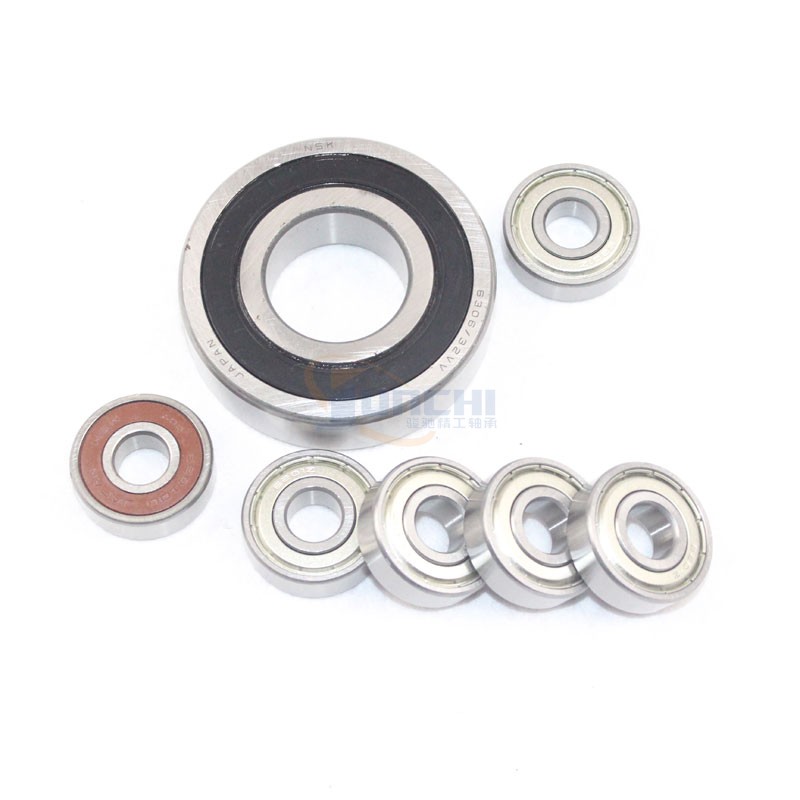Generally speaking, rolling bearings do not produce noise themselves. The usual "bearing noise" is in fact the sound effect of bearing vibration directly or indirectly with the surrounding structure. This is why many times noise problems can be regarded as vibration problems involving the whole bearing application.

(1)因加载滚动体数量变化而产生的激振:当一个径向负荷加载于某个轴承时,其承载负荷的滚动体数量在运行中会稍有变化,这引起了负荷方向的偏移。由此产生的振动是不可避免的,但可通过轴向预加载来减轻,加载于所有滚动体(不适用于圆柱滚子轴承)。
(1) The excitation caused by the change of the number of loaded rollers: when a radial load is loaded on a bearing, the number of loaded rollers changes slightly during operation, which leads to the deviation of load direction. The resulting vibration is unavoidable, but can be reduced by axial preloading on all rollers (not applicable to cylindrical roller bearings).
(2)局部损坏: 由于操作或安装错误,小部分轴承滚道和滚动体可能会受损。在运行中,滚过受损的轴承部件会产生特定的振动频率。振动频率分析可识别出受损的轴承部件。此原理已被应用在状态监测设备,用来探测轴承损坏状况。如要计算轴承频率, 请参看计算程序“轴承频率”。
(2) Local damage: due to operation or installation errors, a small number of bearing raceways and rolling elements may be damaged. During running, rolling over damaged bearing parts produces a specific vibration frequency. Vibration frequency analysis can identify damaged bearing parts. This principle has been applied to condition monitoring equipment to detect bearing damage. If you want to calculate the bearing frequency, please refer to the calculation procedure "bearing frequency".
(3)相关部件的精度:在轴承圈与轴承座或传动轴之间密配合的情况下,轴承圈有可能与相邻部件的外形相配合而变形。如果出现变形,在运行中便可能产生振动。
(3) Precision of the relevant parts: In the case of close coordination between the bearing ring and the bearing seat or the drive shaft, the bearing ring may be deformed by matching the shape of the adjacent parts. If deformation occurs, vibration may occur during operation.
(4)污染物:如果在污染环境中运行,杂质可能会进入轴承并被滚动体碾压。产生的振动程度取决于被碾压的杂质颗粒的数量、大小和成分虽然不会产生典型的频率形式,但可以听得见一种扰人的噪音。
(4) Pollutants: If run in a polluted environment, impurities may enter the bearing and be rolled. The degree of vibration produced depends on the number, size and composition of the crushed impurity particles, which do not produce a typical frequency pattern, but can be heard as a disturbing noise.
滚动轴承产生噪音的原因比较复杂,其一是轴承内、外圈配合表面磨损。由于这种磨损,破坏了轴承与壳体、轴承与轴的配合关系,导致轴线偏离了正确的位置,在轴在高速运动时产生异响。当轴承疲劳时,其表面金属剥落,也会使轴承径向间隙增大产生异响。此外,轴承润滑不足,形成干摩擦,以及轴承破碎等都会产生异常的声响。轴承磨损松旷后,保持架松动损坏,也会产生异响。
The reasons for rolling bearing noise are relatively complex. One is the wear of the bearing inner and outer rings. Because of this kind of wear and tear, it destroys the matching relation between bearing and shell, bearing and shaft, leads to the axis deviating from the correct position, and produces abnormal sound when the shaft moves at high speed. When the bearing is fatigued, the spalling of the metal surface will also cause the radial clearance of the bearing to increase and produce abnormal noise. In addition, bearing lubrication is insufficient, dry friction is formed, and bearing breakage will produce abnormal noises. After the bearing is loose and loose, the cage will loose and damage, and it will also produce abnormal sound.



